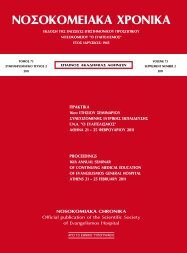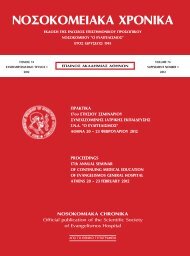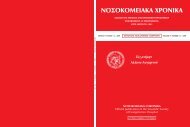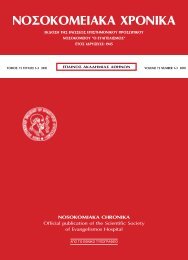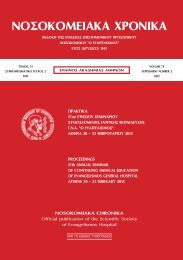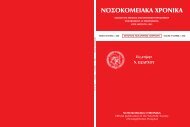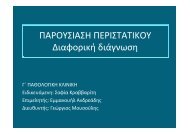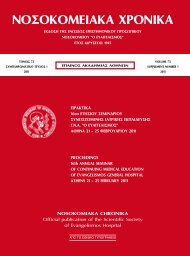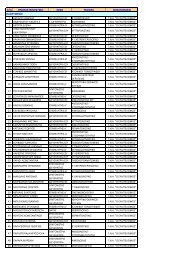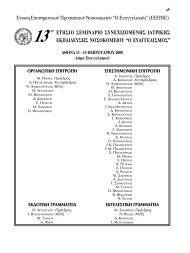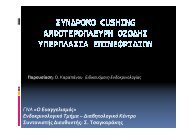åêðáéäåõóçó γ.ν.α.
åêðáéäåõóçó γ.ν.α.
åêðáéäåõóçó γ.ν.α.
You also want an ePaper? Increase the reach of your titles
YUMPU automatically turns print PDFs into web optimized ePapers that Google loves.
Τι νεoτερο<br />
529<br />
ΣΤΙΣ ΜΕΤΑΜΟΣΧΕΥΣΕΙΣ<br />
ΜΥΕΛΟΥ ΤΩΝ ΟΣΤΩΝ<br />
Συντονιστής: Ι Αποστολίδης*<br />
Μεταμοσχεύσεις με μειωμένης έντασης<br />
σχήματα προετοιμασίας<br />
Ι Μπαλταδάκης<br />
xxxxxxxxx<br />
xxxxxxxxxxxx<br />
xxxxxxxxxxxx<br />
SUMMARY<br />
Baltadakis I. Stem Cell Transplantation with Reduced-Intensity Conditioning Regimens. The<br />
recognition of the role of donor immune system in disease control has led in the design of allogeneic<br />
stem cell transplants with reduced intensity conditioning regimens. The underlying principle in reduced<br />
intensity transplantation is replacement of the cytotoxic activity of conditioning by the immune effect<br />
of the graft. By use of reduced intensity conditioning regimens, allogeneic stem cell transplantation has<br />
become feasible in older patients or patients with comorbidities, which are not eligible for conventional<br />
myeloablative therapy. The optimal source of the graft is peripheral blood either from related or volunteer<br />
donors. Engraftment is also achieved by the infusion of unrelated umbilical cord blood. Hematologic<br />
malignancies are the main indication of reduced intensity stem cell transplants, while their application<br />
in solid tumors remains experimental. Outcomes are superior in indolent malignancies which are susceptible<br />
to the immunologic graft-versus-tumor effect, such as chronic lymphocytic leukemia, follicular<br />
lymphoma, and mantle cell lymphoma. Encouraging results have been reported in Hodgkin’s lymphoma<br />
patients with relapse after autologous transplant. Reduced intensity transplantation in myelodysplastic<br />
syndromes and acute myelogenous leukemia is associated with significant reduction in transplant-related<br />
mortality, albeit at the price of increased risk of relapse. Tandem autologous and reduced intensity allogeneic<br />
stem cell transplantation has been studied mainly in multiple myeloma, but has not proved<br />
superior to autologous transplant. Critical unresolved issues in reduced intensity transplantation include<br />
the close association of immune antitumor effect with graft-versus-host disease, delayed immune reconstitution,<br />
and higher incidence of relapse. The role of reduced intensity conditioning needs to be defined<br />
by disease-specific, prospective, randomized trials with direct comparison to myeloablative regimens..<br />
Nosokomiaka Chronika, 71, Supplement, 529-536, 2009.<br />
Key words: Reduced intensity conditioning, Non-myeloablative conditioning, Allogeneic stem cell<br />
transplantation.<br />
* Επιμελητής Α’, Αιματολογικό Τμήμα-Μονάδας Μεταμόσχευσης Μυελού Οστών Γ.Ν.Α. «Ο Ευαγγελισμός»<br />
Επιμελητής Α’, Αιματολογικό Τμήμα-Μονάδας Μεταμόσχευσης Μυελού Οστών Γ.Ν.Α. «Ο Ευαγγελισμός»



